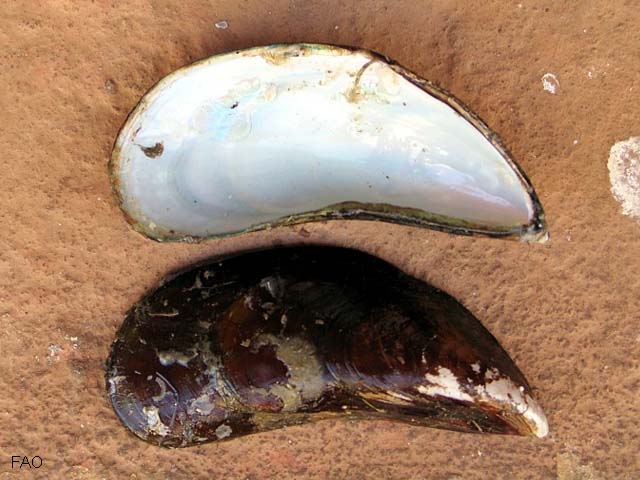| Mytilidae (sea mussels) |
| 16.5 cm SHL (male/unsexed) |
|
benthic; brackish; marine; depth range 0 - 100 m |
| Indo-Pacific and Western Central Atlantic. |
|
Shell elongate, roughly trigonal-ovate in outline, swollen and pointed anteriorly, rounded and compressed posteriorly. Umbones terminal and sharply tapering, rather incurved. Anterior margin reduced. Ventral margin long and often somewhat concave. Outer surface nearly smooth apart from concentric growth marks and faint radial lines. Periostracum rather thick and smooth, adherent. Ligamental ridge finely pitted. Hinge with 1 small tooth in right valve and 2 in the left. Anterior adductor scar absent in adult specimens. Posterior retractor scars large, confluent with the posterior adductor scar. Anterior retractor scar separated, elongate-ovate in shape, situated a short way to posterior end of ligament. Internal margins smooth. Colour: outside of shell whitish under a bright periostracum which is dark brownish green anteriorly and olive-green to bright green posteriorly. Interior an iredescent pale bluish green, with a vivid green margin on periostracum. |
| The figures from FAO comprise the production of Mytilus viridis from Malaysia and Singapore and also production reported under the name Mytilus smaragdinus from the Philippines and Thailand; they all refer to the same species (Ref. 348). Commonly found byssally attached to various hard objects or substrates in protected bays and estuaries (Ref. 80041). Littoral and sublittoral to a depth of 20 m (Ref. 348). Can thrive even in adverse environments due to its ability to tolerate elevated levels of pollutants and oxygen depletion (Ref. 125512). |
|
Not Evaluated (N.E.) Ref. 123251)
|
|
|
Source and more info: www.sealifebase.org. For personal, classroom, and other internal use only. Not for publication.

